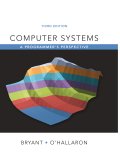
Compile and run the sample code that uses show_bytes (file show-bytes. c) on different machines to which you have access. Determine the byte orderings used by these machines.
Byte ordering:
- Some machines decide to store the objects in memory ordered from least significant byte to most, while other machines store them from most to least.
- The byte ordering are made by the two ways:
- Little Endian
- In little Endian, the least significant byte comes first.
- Big Endian
- In big Endian, the most significant byte comes first.
- Little Endian
Example:
The example for find the little-endian and big-endian for hexadecimal value is shown below:
Here assume that the hexadecimal value is “0x13244860”. Then address range for given ordering byte is “0x200” through “0x203”.
Big Endian for given hexadecimal value is
| 0x200 | 0x201 | 0x202 | 0x203 |
| 13 | 24 | 48 | 60 |
Little Endian for given hexadecimal value is
| 0x200 | 0x201 | 0x202 | 0x203 |
| 60 | 48 | 24 | 13 |
Explanation of Solution
Corresponding code from given question:
#include <stdio.h>
//Define variable "byte_pointer" in char datatype.
typedef unsigned char* byte_pointer;
//Function definition for show_bytes.
void show_bytes(byte_pointer start, size_t len)
{
//Declare variable "i" in int data type.
int i;
/* "For" loop to determine byte representation in hexadecimal */
for (i = 0; i < len; i++)
//Display each bytes in "2" digits hexadecimal value.
printf(" %.2x", start[i]);
printf("\n");
}
//Function to determine byte for "int" number.
void show_int(int x)
{
//Call show_bytes function with integer value.
show_bytes((byte_pointer) &x, sizeof(int));
}
//Function to determine byte for "float" number.
void show_float(float x)
{
//Call show_bytes function float value.
show_bytes((byte_pointer) &x, sizeof(float));
}
//Function to determine byte for "pointer" number.
void show_pointer(void *x)
{
//Call show_bytes function with pointer value.
show_bytes((byte_pointer) &x, sizeof(void *));
}
//Test all show bytes.
void test_show_bytes(int val)
{
//Define variables.
int ival = val;
float fval = (float) ival;
int *pval = &ival;
//Call function.
show_int(ival);
show_float(fval);
show_pointer(pval);
}
//Main function.
int main(int argc, char* argv[])
{
//Define the sample number.
int sampleNumber = 682402;
//Call test_show_bytes function.
test_show_bytes(sampleNumber);
return 0;
}
The given program is used to display the byte representation of different program objects by using the casting.
- Define “byte_pointer” using “typedef”.
- It is used to define data type as a pointer to an object of type “unsigned char”.
- The function “show_bytes” is used to display the address of a byte sequence by using the argument that is byte pointer and a byte count.
- Each byte is displayed by “2” digit.
- The function “show_int” is to display the byte representations of object of “int” data type.
- The function “show_float” is to display the byte representations of object of “float” data type.
- The function “show_pointer” is to display the byte representations of object of “void *” data type.
- Test all the data type values by using function “test_show_bytes”.
- Finally, assign the sample number in main function and call the “test_show_bytes” with argument “sampleNumber”.
Byte ordering used by the given machines:
After compiling and running the above code, the following output will be appear
a2 69 0a 00
20 9a 26 49
3c cc e9 18 ff 7f 00 00
From the above output,
- The byte representation for “int” data type is “a2 69 0a 00”.
- The byte representation for “float” data type is “20 9a 26 49”.
- The byte representation for “int *”data type is “3c cc e9 18 ff 7f 00 00”.
The byte ordering used by these machines is “big-endian”.
- Reason:
- Consider, the byte representation of “int” value is “a2 69 0a 00”.
- From this, the value is ordered from most significant byte to least significant byte. Hence, it is referred as big-endian.
Want to see more full solutions like this?
Chapter 2 Solutions
EBK COMPUTER SYSTEMS
Additional Engineering Textbook Solutions
Web Development and Design Foundations with HTML5 (8th Edition)
Digital Fundamentals (11th Edition)
Starting Out With Visual Basic (8th Edition)
Web Development and Design Foundations with HTML5 (9th Edition) (What's New in Computer Science)
Starting Out with Python (3rd Edition)
 Computer Networking: A Top-Down Approach (7th Edi...Computer EngineeringISBN:9780133594140Author:James Kurose, Keith RossPublisher:PEARSON
Computer Networking: A Top-Down Approach (7th Edi...Computer EngineeringISBN:9780133594140Author:James Kurose, Keith RossPublisher:PEARSON Computer Organization and Design MIPS Edition, Fi...Computer EngineeringISBN:9780124077263Author:David A. Patterson, John L. HennessyPublisher:Elsevier Science
Computer Organization and Design MIPS Edition, Fi...Computer EngineeringISBN:9780124077263Author:David A. Patterson, John L. HennessyPublisher:Elsevier Science Network+ Guide to Networks (MindTap Course List)Computer EngineeringISBN:9781337569330Author:Jill West, Tamara Dean, Jean AndrewsPublisher:Cengage Learning
Network+ Guide to Networks (MindTap Course List)Computer EngineeringISBN:9781337569330Author:Jill West, Tamara Dean, Jean AndrewsPublisher:Cengage Learning Concepts of Database ManagementComputer EngineeringISBN:9781337093422Author:Joy L. Starks, Philip J. Pratt, Mary Z. LastPublisher:Cengage Learning
Concepts of Database ManagementComputer EngineeringISBN:9781337093422Author:Joy L. Starks, Philip J. Pratt, Mary Z. LastPublisher:Cengage Learning Prelude to ProgrammingComputer EngineeringISBN:9780133750423Author:VENIT, StewartPublisher:Pearson Education
Prelude to ProgrammingComputer EngineeringISBN:9780133750423Author:VENIT, StewartPublisher:Pearson Education Sc Business Data Communications and Networking, T...Computer EngineeringISBN:9781119368830Author:FITZGERALDPublisher:WILEY
Sc Business Data Communications and Networking, T...Computer EngineeringISBN:9781119368830Author:FITZGERALDPublisher:WILEY





